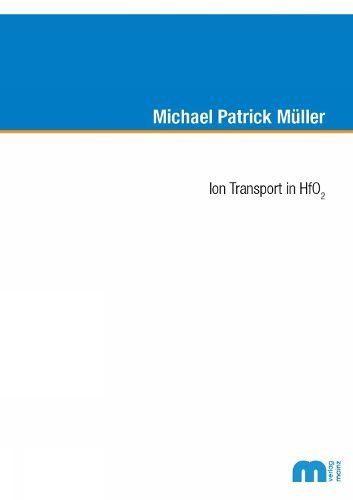Readings Newsletter
Become a Readings Member to make your shopping experience even easier.
Sign in or sign up for free!
You’re not far away from qualifying for FREE standard shipping within Australia
You’ve qualified for FREE standard shipping within Australia
The cart is loading…






In this thesis the diffusion of anions and cations in HfO2 was investigated in detail. Furthermore, the conductivity of HfO2 was probed and approaches to interpret the results were presented. The diffusion of oxygen in dense ceramics of monoclinic HfO2 (m-HfO2) was studied by means of (18O/16O) isotope exchange annealing and Secondary Ion Mass Spectrometry (SIMS). All measured isotope profiles showed complicated behaviour in exhibiting two features: the first feature, closer to the surface, was attributed mainly to slow oxygen diffusion in an impurity silicate phase; the second feature, deeper in the sample, was attributed to oxygen diffusion in bulk m-HfO2. The activation enthalpy of oxygen tracer diffusion in bulk m-HfO2 was found to be ?HD? ? 0.5 eV. The diffusion of cations in m-HfO2 was studied with samples prepared by cooperation partners, utilising a low-temperature preparation method, atomic layer deposition, in order to produce non-equilibrium samples. These were then used in diffusion annealing experiments and investigated with SIMS. The measured isotope profiles displayed two features, attributed to bulk diffusion and grain-boundary diffusion. A numerical analysis produced a bulk diffusion activation enthalpy of ?Hb ? 2.1 eV and a grain-boundary diffusion activation enthalpy of ?Hgb ? 2.1 eV. These values are small compared to other AO2 systems and the difference is attributed to the structural perturbations in the monoclinic system. A computational investigation of cation diffusion in m-HfO2 using Density-Functional-Theory (DFT) yielded migration enthalpies for individual cation jumps. Two jumps were found with values comparable to the experiments (? 2 eV), allowing long-range diffusion through the bulk. Molecular dynamics simulations in c-HfO2 with an applied field were able to reproduce the activation enthalpy of bulk diffusion determined experimentally and with DFT. However, molecular static simulations instead produce results much closer to those of other AO2 systems. A cooperative migration mechanism of oxygen and hafnium vacancies is proposed. The conductivity of m-HfO2 was studied in dependence of the oxygen partial pressure by means of high temperature equilibrium conductance measurements. In reducing conditions the total conductivity was found to increase with oxygen partial pressure. Numerical defect-chemical calculations showed that singly positively charged oxygen vacancies are likely responsible for this behaviour. In the intermediate oxygen partial pressure regime ionic conductivity dominated. In oxidising conditions the total conductivity increased with oxygen partial pressure due to electron holes.
$9.00 standard shipping within Australia
FREE standard shipping within Australia for orders over $100.00
Express & International shipping calculated at checkout
In this thesis the diffusion of anions and cations in HfO2 was investigated in detail. Furthermore, the conductivity of HfO2 was probed and approaches to interpret the results were presented. The diffusion of oxygen in dense ceramics of monoclinic HfO2 (m-HfO2) was studied by means of (18O/16O) isotope exchange annealing and Secondary Ion Mass Spectrometry (SIMS). All measured isotope profiles showed complicated behaviour in exhibiting two features: the first feature, closer to the surface, was attributed mainly to slow oxygen diffusion in an impurity silicate phase; the second feature, deeper in the sample, was attributed to oxygen diffusion in bulk m-HfO2. The activation enthalpy of oxygen tracer diffusion in bulk m-HfO2 was found to be ?HD? ? 0.5 eV. The diffusion of cations in m-HfO2 was studied with samples prepared by cooperation partners, utilising a low-temperature preparation method, atomic layer deposition, in order to produce non-equilibrium samples. These were then used in diffusion annealing experiments and investigated with SIMS. The measured isotope profiles displayed two features, attributed to bulk diffusion and grain-boundary diffusion. A numerical analysis produced a bulk diffusion activation enthalpy of ?Hb ? 2.1 eV and a grain-boundary diffusion activation enthalpy of ?Hgb ? 2.1 eV. These values are small compared to other AO2 systems and the difference is attributed to the structural perturbations in the monoclinic system. A computational investigation of cation diffusion in m-HfO2 using Density-Functional-Theory (DFT) yielded migration enthalpies for individual cation jumps. Two jumps were found with values comparable to the experiments (? 2 eV), allowing long-range diffusion through the bulk. Molecular dynamics simulations in c-HfO2 with an applied field were able to reproduce the activation enthalpy of bulk diffusion determined experimentally and with DFT. However, molecular static simulations instead produce results much closer to those of other AO2 systems. A cooperative migration mechanism of oxygen and hafnium vacancies is proposed. The conductivity of m-HfO2 was studied in dependence of the oxygen partial pressure by means of high temperature equilibrium conductance measurements. In reducing conditions the total conductivity was found to increase with oxygen partial pressure. Numerical defect-chemical calculations showed that singly positively charged oxygen vacancies are likely responsible for this behaviour. In the intermediate oxygen partial pressure regime ionic conductivity dominated. In oxidising conditions the total conductivity increased with oxygen partial pressure due to electron holes.